|
CONTENTS
Not Your Average DE
"Lynch 'Em"
Jackie Robinson's Brief Pro Football Career
Win One for the Gipper
"He's Dead!"
Long Journey
Conference in Disarray
Recount after the Roses
Unhappy Losers
Football
Stories – I
Football Stories –
II
Football
Stories – III
Football Stories – IV
Football Stories – V
Football Stories – VI
Football Stories - VII
Football Stories - VIII
Football Stories - IX
Football Stories - X
Football
Magazine
Golden Rankings Home
Top
of Page |
Interesting
Football Stories–X
|
Not Your Average DE

Paul Kruger
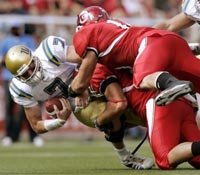
|
Utah was one of the success stories of the 2008 football season. They completed a perfect 12-0 regular season and gained a Sugar Bowl berth.
One of the defensive stars for the Utes was sophomore DE Paul Kruger.
- At age 14, Paul was involved in an accident in the mountains when a jeep rolled and smashed his midsection. After being in the ICU for three weeks, he survived, but lost a kidney. "It was very serious, and I didn't ever plan on playing football or any contact sports again," Kruger said. However, he was cleared to play and wears a protective back flap to protect his one kidney.
- The 6'5" 255 lb Kruger wore #11. As you might guess, that's because he was recruited by previous coach Urban Meyer as a QB but switched to D line. "We knew if it didn't work out at QB that he had a future as a TE or DE," said Ute coach Kyle Whittingham, who was D coordinator when Kruger was recruited. "We gave him the opportunity to play QB. Urban gave him a long time — about 36 hours, I believe."
- Kruger redshirted in 2005, then went on his Mormon mission in 2006. He earned freshman All-American honors at the end of the 2007 season.
- In January 2008, Paul was knifed during a melee outside a Salt Lake City party. He suffered a collapsed lung, and gashes in his abdomen and side took 50 staples to close. He recovered in time to play in all 12 games of the 2008 season.
|
|
|
"Lynch 'Em"
In November 1966, #1 Notre Dame played #2 Michigan State at East Lansing. The "game of the century" was the first time in college football history that the top two teams met so late in the season. The racial makeup of the two teams provided a stark contrast.
- Twelve of MSU's starters were black, including 8 of 11 on D and QB Jimmy Raye.
- One Notre Dame starter was black.
Michigan State under Biggie Munn and then Duffy Daugherty was a pioneer among major colleges in recruiting African-American athletes. For that reason, the school was compared to historically black colleges like Grambling and Florida A&M. In September of that 1966 season, Jerry Levias of SMU became the first black player in the Southwest Conference. It would not be until the next season that the first black player participated in a game for an SEC school (Nat Northington of Kentucky). And even after those breakthroughs, blacks were few and far between at predominantly white schools in the South until well into the 1970s. Even many Northern programs believed that it would be dangerous to play more blacks than whites since blacks did not have the intelligence to handle leadership positions.

Bubba Smith |
MSU's most prominent player was 6'7" 283 lb African-American DT Charles "Bubba" Smith, a Texas native who had never played in an integrated stadium until college. On the other hand, Fighting Irish football was epitomized by Jim Lynch, an Irish-Catholic All-American LB from Ohio. At a pep rally two days before the big game, 4500 students and fans packed the Notre Dame fieldhouse to cheer and sing the fight song. Hanging from the rafters was an effigy of Bubba Smith next to a sign that said "LYNCH 'EM." It's hard to believe the person(s) who displayed the effigy and sign – and, indeed, most of the people in the gym – were unaware of the history of the civil rights movement in the South and the use of lynching by white supremacists to fight integration. One wonders what the few black students at Notre Dame thought about the scene.
|
|
Jackie Robinson’s Brief Pro Football Career
The Hawaii Senior Football League in 1941 consisted of the University of Hawaii Rainbows, the Na Aliis, the Healani Maroons, and the Honolulu Bears. (The Rainbows played semipro teams to fill out their schedule.) Bears' owner Francis "Brick" Brickner snared a player who would later become much more famous in another sport.
Jackie Robinson had played two years at UCLA where he became the only athlete in school history to letter in four sports (football, baseball, basketball, and track). However, he quit school with one semester to go to pursue an athletic career full-time. Finding that mainland pro teams had no place for African-American players, Robinson responded positively to Brickner's offer of $100 per game. In September, 1941, Jackie sailed to the islands, where he worked part-time on a construction job near Pearl Harbor. On the Bears, he played QB, HB, and returned punts. However, an injured ankle hampered his performance, and the Bears won only two games. When the team closed its season on December 3 by losing to Healani 19-13, rain and wind limited the crowd to 550.
On December 5, 1941, Jackie sailed for California. The ship set a leisurely course which the captain quickly changed when he received word two days later of the Japanese attack on Pearl Harbor. To avoid detection, crew members painted the ship's windows black. In addition, the captain ordered all passengers to wear life jackets in case of an attack. None came, and Jackie arrived safely in California. He soon entered the Army and never played football again.
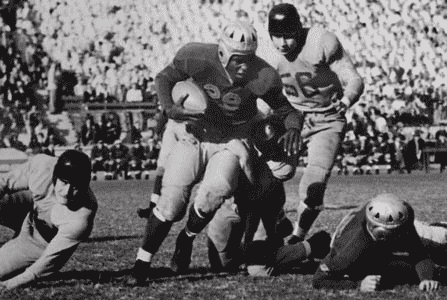
Jackie Robinson running for UCLA against Oregon State in 1939
|

Knute Rockne
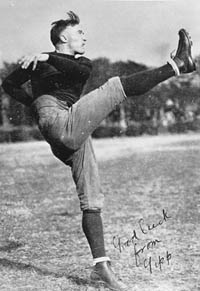
George Gipp

Ronald Reagan as George Gipp in "Knute Rockne, All American"
|
The destruction of Yankee Stadium following the 2008 baseball season meant the death of the locker room where Knute Rockne gave his most famous speech.
Date: November 12, 1928
Occasion: Notre Dame tied with Army 0-0 at halftime.
In those days, the Yankees used the third base dugout. (They switched to first base in the 1940s.) So it was in that locker room that Rockne told his team about former Fighting Irish star RB George Gipp on his deathbed telling him that, when the team ever needed inspiration, implore them to "win one for the Gipper." Of course, the story would not have come down to history if Rockne's boys hadn't won the game 12-6.

Notre Dame-Army 1928
The story was immortalized in the 1940 film "Knute Rockne, All-American" when Pat O'Brien, playing Rockne, tells the story to the team while sitting in a wheelchair. Ronald Reagan played Gipp in the movie, and when he entered politics, one of his nicknames was "Gipper." The phrase "Win one for the Gipper" became a Republican rallying cry.
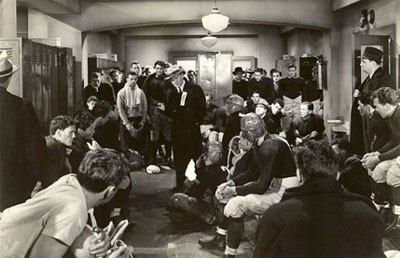
Pat O'Brien in "Knute Rockne, All-American"
George Gipp played for Rockne in his first three years as ND coach, 1918-1920. Intent on lauching a career in major league baseball, Gipp was persuaded by Rockne to go out for football. He led the Irish to 21-1-2 record during his three seasons of varsity ball. However, George caught a throat infection during one of his final games. He kept playing, making his condition worse. He died a few weeks later at age 25. Did the dying Gipp actually say the words that Rockne recounted to his team in 1928? Probably not. More shyster than saint, Rockne was known to make up stories for inspirational purposes.
The movie scene pictured above actually combines two Rockne stories. The wheelchair comes from the next season, 1929, when Rockne coached from a wheelchair because he had been diagnosed with life-threatening phlebitis. ND went 9-0 and won the national championship. After the blood clot in his leg burst after the USC game and amazingly settled in his other leg, he missed the last two games entirely. He regained his health for the 1930 season.
As further background for that 1928 game at Yankee Stadium, Rockne's squad entered the Army game with only 4-2 record. His previous ten teams had lost two games in an entire season only once – the 1925 team finished 7-2-1. Although the Irish pulled out the Gipper game, they lost the remaining two to Carnegie Tech (27-7) and USC (27-14) to finish with the worst record (5-4) of any team in Rockne's 13-year tenure.
Knute's career was cut short when he died at age 43 in a plane crash on March 31, 1931. He was bound for Los Angeles where he was to help produce the movie "The Spirit of Notre Dame" for a lucrative salary. Shortly after takeoff from Kansas City, the plane hit bad weather and went down in a wheat field.
|
|
"He's dead!"
The closing of Yankee Stadium after the 2008 baseball season evoked many lists of top memories in multiple sports that occurred in The House That Ruth Built. Undoubtedly, the list of "greatest hits" begins with Chuck Bednarik's layout of Frank Gifford in 1960.

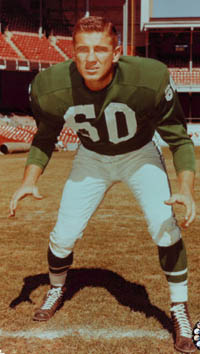
Chuck Bednarik
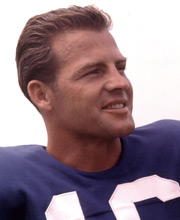
Frank Gifford
|
Bednarik was the fierce C-LB of the Philadelphia Eagles. Gifford was the star HB-WR of the New York Giants. Trailing the Eagles 17-10, the home team was trying to mount a late comeback. Cutting over the middle, Gifford reached behind him to catch QB Charlie Conerley's pass, then turned upfield. "Concrete Charlie" Bednarik happened to be right in Frank's path. What happened next changed both their lives forever. "Chuck knocked him right out of his shoes," Eagles DB Tom Brookshier said. Bednarik's destructive hit on Gifford left him unconscious on his back with a severe concussion.
As Eagles LB Chuck Weber recovered Gifford's fumble – how could he not have fumbled? – Bednarik stood over Gifford, pumping his right arm and yelling. "This ------ game is over."
"I was celebrating," Bednarik said, "but the reason wasn't that he was down. The reason was that the hit won the game."
"It was perfectly legal," Gifford said later. "If I'd had the chance, I'd have done the same thing Chuck did."
As Gifford was being carted away on a stretcher, he heard someone say, "He's dead." It turned out they were referring to a security guard who had had a heart attack. What did fans think shortly afterwards when they saw a body covered by a white sheet being carried out one of the exits? Was it their beloved Frank? He wasn't dead, but he did miss the rest of that season and all of 1961 as well. He did return to play from 1962-4 before retiring.
The Eagles won the NFL Championship in 1960 over the Green Bay Packers in the only championship game that Vince Lombardi ever lost.
Many years later, the two Hall of Famers met at a banquet. "Hey, Frank," Bednarik said, "good to see you. How are you doing?" Gifford replied, "I made you famous, didn't I, Chuck?" "Yes, you did, Frank," Bednarik replied. "Yes, you did."
In today's NFL, Bednarik would be penalized 30 yards – 15 for unnecessary roughness and 15 for unsportsmanlike conduct. He would also be fined a large sum and suspended for multiple games. A forearm to the head of a defenseless receiver is not considered a clean hit any more.
|
|
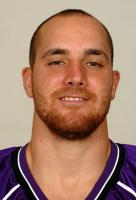
Billy Don Malone
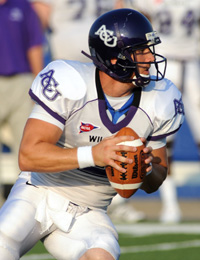
Malone in action
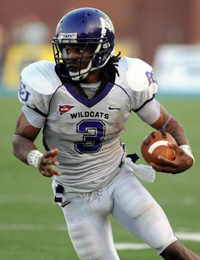
Bernard Scott
|
Billy Don Malone had the quintessential name for a high school QB from Texas. He also had the essential physical tools to succeed in college: 6'3", 190 with a strong arm.
Malone verbally committed to Texas in the summer of 2001 before his senior season. However, he ended up withdrawing his pledge that December because, he said, Mack Brown had discouraged him from visiting Tulane, where his brother, a WR, was visiting. The fact that Brown had gotten a commitment from Vince Young may also have influenced Billy Don's decision. He ended up shunning Tennessee, LSU, and ten other suitors to sign with the Green Wave along with his brother.
Needless to say, Tulane coach Chris Scelfo was ecstatic, calling Malone "C.E." for the contract extension he would bring his coach. Already blessed with an NFL-caliber QB in J. P. Losman, Scelfo redshirted Billy Don his freshman year. He immediately impressed his teammates. "He had all the tools," says Losman. "He had the size. He had the heart, which was probably the key. He was a very tough guy. He had the arm. He had the smarts. He understood football."
Unfortunately, Malone didn't understand life yet and had a physical ailment that soon manifested itself. He began experiencing heart problems that a doctor diagnosed as a heart abnormality. Upon the doctor's recommendation, Tulane told Billy he could not play football any more, but they would honor his scholarship.
Faced with the loss of what he valued most, Malone stopped going to class and partied even harder. He began binge drinking occasionally, and, in the summer of 2003, he was arrested for his part in a fight back home in Paris TX. He pleaded guilty to a misdemeanor. When he returned to Tulane for the fall semester, he began smoking pot, usually with other players. In December, he was arrested for DUI. He trudged on through the spring semester but left TU for good after that with less than 24 credits in two years.
In September 2004, he experienced a religious conversion. He married Ashley, his pregnant girlfriend, and stopped smoking marijuana. He also received clearance from a Dallas cardiologist to play football again. He went to a nearby college to make up the credits he needed to play football again.
He transferred to Abilene Christian for the 2005 season, quickly becoming the starting QB. He finally lived up to his potential in 2006, throwing for 3,136 yd and 27 TDs with only six INTs. Abilene made its first Division II playoff appearance. In 2007, his numbers were 3,914/37/14. Up to 230 lb by 2008, he completed his college career with another 3,000 yd season and 36 more TDs.
NFL scouts rated Malone as having a good arm but sloppy mechanics. Being 25 was not a point in his favor either. As a result, he was not drafted during the nine rounds last April. As this is written, he has worked out for several NFL teams but was not signed by any of them.
Another Abilene player who has a troubled past, RB Bernard Scott, was selected in the draft - in the sixth round by Cincinnati. Arrested at least five times, he played for four different colleges before ending up at ACU for his senior year. On the gridiron, he's dynamite, leading Division II in scoring and all-purpose yards, including 2,210 rushing to win the 2008 Harlon Hill Trophy as the best Division II player. Keep an eye on Bernard to see if he can conquer his anger issues and succeed in the NFL.
Reference: "A Matter of Heart," Thayer Evans, New York Times, 11/29/2008
|
|
"The brave new AAWU rises from the ashes of the strife-torn PCC."
That was the headline for a story in the September 21, 1959, Sports Illustrated.
- PCC = Pacific Coast Conference
- AAWU = Athletic Association of Western Universities.
The PCC had existed since 1915.
- The charter members were: California, Washington, Oregon, and Oregon Agricultural College (now Oregon State).
- Two other schools soon joined: Washington State (1917) and Stanford (1918).
- Later members were: Southern California (1922), Idaho (1922), Montana (1924), and UCLA (1928).
These ten schools comprised the conference for 22 years until Montana left in 1950. One plum for the conference from its inception – publicity-wise as well as financially – was that its football champion hosted the Rose Bowl.
The PCC tried to be strict with regard to academic and eligibility standards. USC was suspended for the 1924 school year. There was a continual tension between the larger California schools and the smaller "northern schools," which were not considered to have nearly as high academic standards as the Golden State members.
The biggest crisis for the conference started in 1951.
- The Oregon football coach, Jim Aiken, was shown to have violated the rules regarding financial aid to athletes. Victor O. Schmidt, the conference commissioner, threatened Oregon with expulsion and demanded that it fire Aiken, which it did. (Aiken had compiled only a 21-20 record in four years.)
- Oregon retaliated by pointing the finger at Red Sanders, the UCLA coach. This led to five years of investigation of charges and countercharges.
- 1956 proved to be tumultuous year for the PCC.
- In January, several Washington players rebelled against their coach, "Cowboy" Johnny Cherberg (who later became lieutenant governor of the state), resulting in his firing. Following up on charges of rules violations, the conference uncovered a slush fund for athletes and imposed sanctions in May.
- In March, LA newspapers published articles on payments to UCLA players by two booster clubs. After refusing a PCC investigation for ten weeks, the school finally admitted that football coaches had been aware of the payments for several years.
- A UCLA booster then pointed to similar activities at Cal and USC.
- The result was that four of the nine conference members were slapped with heavy penalties, the most telling of which were disbarment from the Rose Bowl and a reduction in the school's cut of the conference payment from the game.
The two California public universities, Cal and UCLA, began to take steps to withdraw from the conference. This led to a chain reaction that caused the PCC to be dissolved in June 1959. (The bitterness was so sharp that all the records in the conference office were destroyed.) The four schools that had been penalized in 1956, plus Stanford, immediately formed the AAWU. Stanford's inclusion was surprising since it had voted for UCLA's expulsion from the PCC.
As the SI article pointed out, the AAWU was, "to say the least, loosely governed."
- One provision in the AAWU code read: "There shall be no central enforcement agency of this association."
- Each school was to govern itself under the honor system in matters of recruiting and eligibility.
- Tom Hamilton, onetime Navy player and coach and former Pittsburgh AD, was hired as the executive director but not given much power other than to conduct meetings.
- One coup for the new conference was signing a new contract with the Tournament of Roses to send its champion to the New Year's Day game starting with the 1960 season.
Three of the PCC schools left out of the AAWU, Oregon, Oregon State, and Washington State, felt that the other five used the football penalties as an excuse to do what they had wanted to do for decades – get rid of the smaller and (allegedly) academically weaker members. (Idaho had not been competitive in the PCC for awhile and didn't apply to join the AAWU.) This accusation brought denials from the five charter AAWU schools who, in fact, soon admitted the other three - WSU in 1962 and the two Oregon schools in 1964. However, there was no provision in the AAWU rules requiring schools to play all the other members. In practice, though, teams did play complete round-robin schedules in the various sports.
The conference eventually strengthened its bylaws in keeping with reforms sweeping across the entire NCAA. In 1968, the AAWU renamed itself the Pacific Eight Conference. When Arizona and Arizona State were admitted in 1978, the name was changed to the current Pacific-10.
|
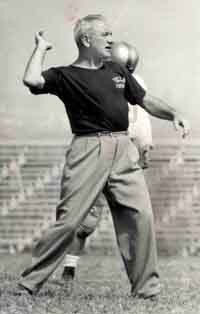
Red Sanders
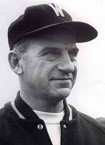
John Cherberg
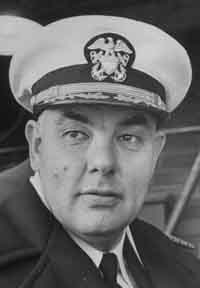
Tom Hamilton
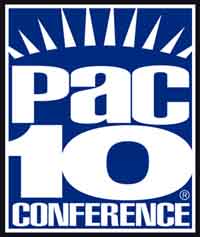
|
|
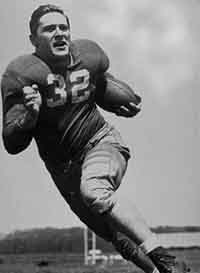
Johnny Lujack, Notre Dame QB

Frank Leahy, Notre Dame coach
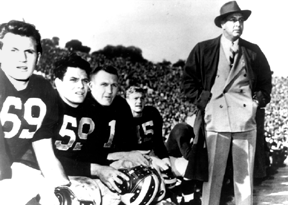
Fritz Crisler, Michigan coach, and players at 1948 Rose Bowl
|
The Associated Press (AP) poll began in 1936. Until 1969, the final poll was conducted at the end of the regular season. No new poll was taken after the bowl games. Except for one year - 1947.
- Notre Dame defeated USC 38-7 in the regular-season finale. Since school policy prevented the Irish from going to a bowl, they completed a 9-0 season.
- Michigan defeated Ohio State 21-0 to finish 9-0 as well. However, the Wolverines as Big Ten champions went to the Rose Bowl to play USC, the Pacific Coast Conference champs, in the second year of the Tournament of Roses' agreement with the two conferences (an agreement that continues to this day).
- The final poll of AP sportswriters listed ND #1 and UM #2. No further poll was scheduled after the bowl games.
But a funny thing happened on the way to 1948.
- Michigan clobbered USC 49-0 before 93,000 on New Year's Day in Pasadena.
- Objective analysts, as well as Wolverine fans, pointed out that Michigan and ND had played three common opponents.
- Pittsburgh: ND 40-6, UM 69-0
- Northwestern: ND 26-19, UM 49-21
- USC: ND 38-7, UM 49-0
- Total score in the three games: Notre Dame 104-32, Michigan 167-21.
- As a result, sports writers demanded a new vote. So the AP conducted a special two-team vote by an expanded list of 357 sports editors and football writers from coast-to-coast.
- Michigan won the revote 226-119-12.
- The 54 voters who had seen both teams play chose Michigan by a 33-17-4 count.
One dissenting voice was soon heard – the USC players.
- The United Press International (UPI) questioned 22 Trojans as to which team they thought was better. 17 favored the Irish.
- One anonymous player said, "We played a better game against Notre Dame than we did against Michigan."
- Right after the Rose Bowl pounding, USC coach Jeff Cravath said, "Michigan wouldn't beat Notre Dame's first team."
There were other polls, usually based on a mathematical ranking system of the inventor.
- Michigan was #1 in the Berryman, Billingsley, Boand, DeVold, Dunkel, Football Research, Houlgate, Litkenhouse, National Championship Foundation, and Poling rankings.
- The Helms Foundation split its vote between Michigan and Notre Dame. Williamson selected Notre Dame.
Despite the fact that the Irish lost the revote when it didn't play in a bowl game, the school continued its post-season ban until 1969. |
|
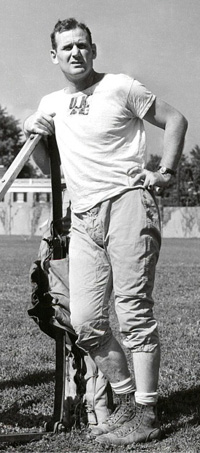
Paul "Bear" Bryant
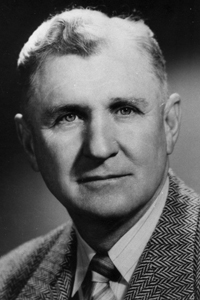
Matty Bell
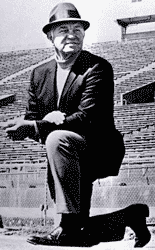
John Vaught
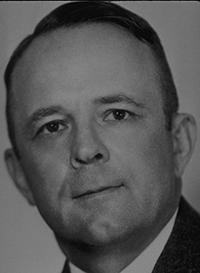
Leo "Dutch" Meyer
|
On October 22, 1949, two SEC schools visited Southwest Conference teams just a few miles apart and came away losers. Each visiting coach criticized the Southwest Conference officials after the game. Both coaches made the College Football Hall of Fame. Here are excerpts from AP reports on the games.
- SMU 20 Kentucky 7
Coach Paul "Bear" Bryant took his crestfallen Kentucky team home Sunday but left behind a stinging rebuke of the officials whom he charged with losing a football game to Southern Methodist.
After the game, in which the Methodists toppled Kentucky from the nation's unbeaten ranks 20-7, the youthful Wildcat mentor loosed a blast at the officials, particularly referee Ray McCulloch, declaring, "I'd rather have that referee on my team than any of my players."
In a somewhat toned down statement Saturday night, Bryant said, "There is no doubt at all that the best team won this afternoon. I want to make this clear that coach Matty Bell and his boys did a wonderful job. I want to make this clear, too, that if we were to play the game again next week, I would not choose those same officials."
Statistics of the game showed Southern Methodist was penalized more than Kentucky – 55 yards to 51 – but Bryant singled out a ruling of interference on a pass and a couple of 15-yard penalties for roughing for criticism. He said the interference penalty was "all wrong" and that the roughing penalties were "uncalled for by my books."
Bryant did not comment on an offside penalty that took away a 68-yard touchdown run by Emery Clark of Kentucky or a 15-yard penalty for illegal use of the hands that halted a drive that appeared touchdown bound. The pass interference gained Southern Methodist six yards and led to an SMU first down that kept a drive going to a touchdown.
Coach Bell of Southern Methodist would not comment other than to say that "I think the officials did their best and if they made mistakes it was not intentional. I consider Ray McCulloch a capable official."
Two officials from the Southwest Conference ... and two from the Southeastern Conference were used in the game.
- TCU 27 Mississippi 23
Coach Johnny Vaught left here [Fort Worth] Saturday night by plane with his Mississippi football squad bound for Oxford but he left behind a blistering criticism of the officiating in Texas Christian's 33-27 victory over his Rebels.
"I can't understand the officiating," Vaught snapped after the game Saturday night. "I thought I had seen the worst. I just can't understand it. It just wasn't consistent officiating."
He did not single out any particular incident but Mississippi was penalized 122 yards and Texas Christian 55. One penalty against Mississippi was on a pass interference ruling that set TCU on the Mississippi 25-yard line. Then followed a personal foul that moved the ball to the one from which TCU scored. That made the count Mississippi 20, Texas Christian 19.
Then in the third period a 52-yard pass that carried Mississippi to the Texas Christian 16-yard line was called back for illegal formation. Mississippi was leading 27-26 then.
Coach Leo "Dutch" Meyer of Texas Christian, who broke into the headlines several weeks ago by charging Arkansas played too rough and used too many hands and elbows in beating TCU, had no comment on Vaught's statement.
Ole Miss ended the 1949 season, Vaught's third as head coach, with a 4-5-1 record. In 1950, the Rebels defeated TCU in Memphis 20-7.
Bryant's fourth Wildcat squad finished 9-2, the other loss coming to Tennessee in the finale. They played in the school's first major bowl game, the Orange Bowl, losing to Santa Clara 21-13.
|
|
|

























